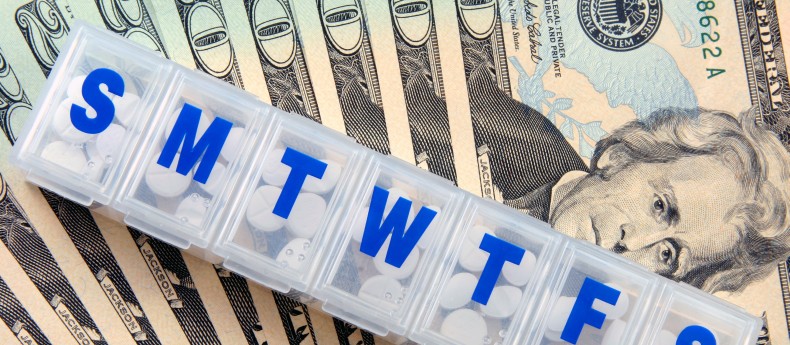
Counterfeit Medicine Around The World
In June 2010, 61 patients out of the 116 who were treated at the Shanghai No. 1 Hospital were injected with a fake version of Avastin (chemical name: Bevacizumab), a medicine approved for colorectal cancer and age-related macular degeneration (AMD). These patients developed various side effects including pain, red eyes, and unclear vision after taking the drug, sparking an investigation by China’s State Food and Drug Administration (SFDA) and widespread interest from national media. In the end, the SFDA concluded that the batch of Avastin used on the patients was actually a counterfeit drug. Avastin was not even an officially registered pharmaceutical product in China at that time.
Counterfeit medication is a serious global issue. The World Health Organization (WHO) has defined counterfeit drugs as medications or pharmaceutical products that are produced and sold with the intent to misrepresent the product’s origin, authenticity, and/or effectiveness. Counterfeit medicines include products that list incorrect ingredients, do not list active ingredients, list insufficient or too much of the active ingredient, and products displayed in fake packaging.
Counterfeits of most major medications have been discovered around the world, from lifestyle drugs (such as drugs for erectile dysfunction like Viagra or Cialis) to life-saving drugs and expensive oncology (cancer) medications. The impact of counterfeit drugs is widespread.
Counterfeited drugs are strongest in regions where regulatory and enforcement systems are still developing. The World Health Orgainzation states that even industrialized countries, such as Australia, Canada, Japan, New Zealand, Europe and the USA have incidences of counterfeit medicine (less than 1% of the market value). In countries where regulatory and enforcement systems for medicines are weaker, such as parts of Asia, Latin America and Africa, the percentage of counterfeit medicine may be greater.
The global counterfeit medication problem also occurs in China. In 2007, an anti-diabetic traditional Chinese medicine was found to contain six times the normal dose of glibenclamide, a WHO-listed essential medicine used the world over to fight type II diabetes. This fake cocktail with its large dosage killed two patients in Xinjiang, and nine more individuals were hospitalized due to severe hypoglycemia. These drugs posed serious public health risks and led to artificially increased resistance levels in individuals who took anti-malarial medicines that contained insufficient active ingredients.
In developing countries, the demand for cost-effective drugs is great. Paying for medicines can consume a significant portion of an individual’s or a family’s monthly income. People, therefore, naturally seek medicines that are sold more cheaply, and these are often available from non-regulated outlets, such as Internet sites. Cheaper drugs and drugs bought online are more likely to be counterfeit drugs. Unfortunately, the counterfeit medicine business can be very lucrative, thus encouraging ever-increasing efforts to supply them. Because many countries have not yet enacted legal punishment for pushing fake medication, counterfeiters often do not fear prosecution or penalties. Even if penalties were imposed, they would likely be small compared to potential profits.
To effectively fight counterfeit medicines around the world and in China, key stakeholders – including health care professionals, manufacturers, law enforcement officials, and others – must combine their efforts. In 2006, the WHO helped to create the International Medical Products Anti-Counterfeiting Taskforce (IMPACT). To prevent the manufacturing and distribution of counterfeit medicine, IMPACT has implemented and enforced legislative and regulatory infrastructures. New packages are likely to have more anti-counterfeit components – including radio frequency identification (RFID) and coding devices for approved medicines – so that consumers can clearly check the authenticity of pharmaceutical products and trace their supply chains.
In the United Family Healthcare (UFH) network, the mission of the UFH Pharmacy is to always provide the safest, most effective medications for our patients. UFH places the utmost importance on ensuring that our pharmaceutical inventory officers always obtain medicines through designated, certified, and reputable distributors. We carefully inspect the outer packaging and safety seals of each individual medication we receive. Any irregularities are promptly reported to the distributor and to the SFDA. UFH provides another protective shield to our patients by giving them the widest choice of branded medications in China. In addition, our pharmacists and hospital staff are trained to always carefully monitor and report adverse drug reactions to medicines, especially when multiple patients are involved.
Patient education/awareness is another big factor in curbing the use of counterfeit medication. Some people have been offered money for their drugs or even for the outer packaging and empty vials. No matter where you are based, patients should always be careful to only buy prescription medicines from authorized drug stores or hospital pharmacies and not through uncontrolled sources like online shops. If the price of a certain medicine seems too good to be true, the medicine is most likely fake. Patients should learn how to inspect pharmaceutical packaging and spot signs of tampering. UFH pharmacists are uniquely trained and always willing to help answer patient questions about the integrity of any medicine. In the end, it is up to the buyer to be aware of counterfeits, so please be careful when purchasing medicine.
Copyright United Family Healthcare 2014 All right reserved - 京卫网审[2014]第1927号 - 京ICP备13017554号-4
深圳新风和睦家医院 广审号:粤(B)广[2024]第09-10-1049号


